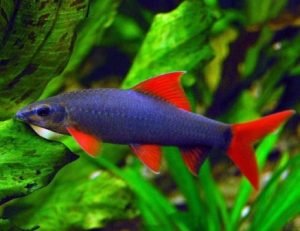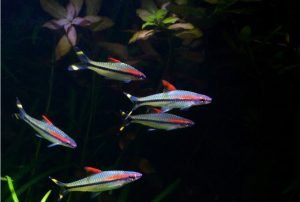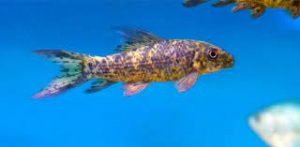If you’re interested in sharks, you’ve probably wondered if you could have one as a pet.
Can you have a shark as a pet? While the ocean swim varieties are too large for hobby tanks, there are many shark species that are suitable for freshwater aquariums and ponds. We’ve rounded up the most popular species and created this detailed maintenance guide to help you design the best tank for your freshwater aquarium sharks.
While it is nearly impossible to have a real shark as a pet, there are many freshwater aquarium sharks that thrive in a home aquarium.
Technically, these fish are not real sharks.
They are large shark-like fish that normally belong to the catfish or carp family.
That said, they often look and act like sharks, which is how they earned their name.
We’ve put together a comprehensive list of the best freshwater sharks to keep in your tank. Some are big, some small, but they are all great!
Best 10 Types of Freshwater Aquarium Sharks
Best Freshwater Aquarium Sharks Review
1. Bala Shark

Young Bala sharks are only about 3 inches long, but don’t let their small size fool you. On average, they grow to about 12 inches (30 cm) in length in adulthood, although they can reach up to 20 inches.
Bales need an aquarium that is at least 75 gallons and at least four feet long to give them enough room to stretch their fins. Bullets, like most freshwater sharks, thrive in a large tank, so it’s a good idea to buy the largest you can afford.
Taking care of them is quite easy. They are not picky eaters, but they are omnivores and love a variety of foods.
A good idea about bullet sharks is that they are not particularly aggressive, so you should not be too careful when choosing tankmates.
Make sure what you choose is too big to fit in the muzzle of a bullet and not too aggressive.
2. Red Tail Shark

The red-tailed shark has a very distinctive appearance. The sleek black body and bright red tail really stand out in a planted tank.
In fact, their preferred environment is one with plenty of hiding places among plants, rocks and driftwood, so a planted tank is the perfect place for them.
One thing to keep in mind is that these sharks don’t like each other, so you can only have one in your tank.
Also avoid other sharks and catfish, as well as fish with long fins. Red tail sharks are very territorial and can be quite aggressive.
These sharks are not picky eaters, but they do like a variety of meats and plant foods. A flake-based diet pellet is fine, but adding a few brine shrimp several times a week will make your red tail very happy.
3. Iridescent Shark

If you’re looking for a shark that’s, well, giant, the iridescent shark is about 3 inches long as a juvenile, but it can grow to over 50 inches.
To keep an iridescent shark, you need an aquarium of at least 300 gallons.
Under the right conditions, iridescent sharks will live up to 20 years if cared for properly. While it may be tempting to keep them in a smaller tank, it’s not a good idea. This pet is definitely an investment and is not for everyone.
While iridescent sharks are technically catfish, they don’t feed on the bottom. They are very active and need a lot of space to swim at different levels in the aquarium.
Iridescent sharks are very gentle, but they will eat any fish they can fit in their mouths, and because they grow so big they will eventually be able to eat almost anything. If you really want tank mates, try aluminum foil skewers or plecos.
4. Silver Apollo Shark

Silver Apollos are actually schools of fish that are quite passive and grow to about 6 inches (15 cm) in length.
Since they like company, it is best to keep them in groups of 5 or more. They are fast swimmers and can even jump out of the tank, so make sure to keep it covered.
Although they are easy to feed and peaceful in nature, silver apoli can be difficult to maintain as they are very sensitive to pH changes and even the slightest amount of ammonia and nitrites in water. They require a strong filter and a 25% weekly water change.
These freshwater sharks are quite easy to live with as long as their fellow residents are not small enough to be eaten.
While not aggressive, they are fast and live close to the surface, so they will compete for food and may prevent slower fish from getting enough to eat.
5. Rainbow Shark

Another freshwater shark that is actually a catfish is the rainbow shark. They are a great addition to a planted tank.
Since they like a lot of hiding places, you should give them lots of dense plants, caves and burrows for them to explore.
Rainbow sharks are very territorial and should not be kept with other sharks, especially red tail sharks. If you’re looking for aquarium mates, try fish larger than them with a similar temperament. They should not be overly aggressive, but still be able to defend themselves.
Rainbows will chase peaceful fish, so avoid them at all costs.
Although rainbows prefer the bottom of the tank, they have tender points around their mouths that can be easily injured.
Choosing the right substrate is essential to avoid injury. Only use a sandy or slippery surface as larger, rougher rocks can cause some damage.
These fish tend to stay at the bottom of the tank, but will explore everywhere. Believe it or not, they are actually very good jumpers, so make sure to keep the top of the tank covered.
6. Violet Blushing Shark

Unlike other freshwater aquarium sharks, the Violet Blushing Shark is quite passive. It does not show territorial behavior as you would see it in other species. As a result, they do well in community tanks.
That said, you should still avoid keeping these fish with smaller creatures that they can see for food. They do best with medium sized fish.
Violet blush sharks get their name from their unique appearance. The fish are covered with a silvery white color. You can see some glow on their bodies, but only when they are under powerful lights.
The bodies are transparent, allowing you to see individual organs. The most prominent feature of the shark’s body is the gills. The gills are visible through the body, making it look like a fish is blushing!
Keeping an aquarium in good condition is crucial for these fish. They need stable temperatures between 68 and 78 degrees to stay healthy. That’s not all. The Violet Blushing Shark should also have plenty of room for swimming.
7. Columbian Shark

Here’s a strain that can be quite challenging to care for. The Colombian shark has strict care requirements. Unfortunately, there is a lot of misinformation circulating.
Contrary to popular belief, these are not entirely freshwater sharks. When they are young, they need brackish water to stay healthy. When you set up your aquarium, you should add a little sea salt to make sure the specific gravity is between 1.005 and 1.010.
Colombian sharks also tend to be troublesome when kept with other fish. These are predatory creatures that prey on smaller species of fish. That’s why you want to avoid smaller passive fish.
Another way to prevent predatory behavior is to keep your fish well fed. The Colombian shark thrives on a high-protein diet of live and frozen foods. They also work well with pellets and commercial dry food. However, they prefer live food that they can hunt.
In appearance, these fish are one of the most shark-like species you can get for your tank. They have a large sail-shaped dorsal fin. Their bodies are usually covered in shades of black, gray, and silver.
On the heads of the fish you will notice that they have several pairs of long barbs. These chins are used to navigate their environment and hunt for food.
8. Black Shark

The black shark is covered in black and has that familiar profile that many freshwater sharks share. This includes a huge dorsal fin. When the fish is swimming, the dorsal fin will generally be relatively flat against its rounded body. However, he will also occasionally stand up while the fish is showing off.
The black shark can become very aggressive and predatory. They should not be kept with small fish species. Most aquarists will house them along with other aggressive species that can handle the intimidating nature of the black shark. This includes some types of cichlids.
Interestingly, these fish do not require a pure protein diet. Some proteins are good, but they are omnivores who will eat almost anything. They have a predilection for foods of plant origin. In fact, these fish are known to eat plants.
Therefore, the Black Shark is recommended for tanks that are scarce in the plant department. They do best with plenty of open space for swimming. Many caves are also recommended for them to have places to rest.
9. Roseline Shark

These flashy fish are absolutely amazing! The Roseline Shark is covered in several bright colors that look great against a natural background. You see red, black and gold stripes. Green and yellow spots are also quite common.
Like all freshwater sharks, these fish have a pronounced dorsal fin. In the case of Roseline Sharks, the dorsal fin is accented with a vibrant fiery red stripe.
Roseline sharks are actually part of the baleen family and are some of the smallest freshwater aquarium sharks you can get. However, this can be good when it comes to temperament.
For the most part, these sharks will not be a problem in terms of aggression. They are quite peaceful and pay no attention to other fish in the community. In groups of four to six, the fish will look even better and show playful behavior.
Roseline sharks can tolerate a wide variety of conditions. They can stay healthy in temperatures between 60 and 77 degrees, although somewhere in between is preferred. What they do need is a strong current. Fish are naturally found in rivers and streams, so it is essential to replicate them with a powerful pump.
10. Harlequin Shark

Known scientifically as Labeo cyclorhynchus, harlequin sharks are an interesting addition to freshwater tanks. They are quite beautiful. However, the fish is known to lead a very solitary life.
They don’t like to be around other fish. In fact, they are known to be very territorial against similar looking species. That means you can’t keep them in groups or with other freshwater sharks.
However, you can house them with some fish if you have enough space. The harlequin shark is a bottom-dwelling fish and spends most of its time in hiding. Therefore, they can be kept with larger species that stay towards the top of the water column.
What is a Freshwater Aquarium Shark?
Domestic sharks are not real sharks, but fish that resemble sharks. There is a wide variety of shark-like fish that make great aquarium pets, and some are even great for community tanks! These small species of freshwater sharks have some similarities with each other:
- Mini sharks have long torpedo-shaped bodies and erect, prominent dorsal fins. It is also common to see deeply forked flukes (tails) on freshwater sharks.
- They are usually members of the catfish or carp family and act as omnivorous scavengers, eating plant matter such as algae and other animals.
- Sharks are generally active and entertaining pets that like to swim in strong currents, and many species will congregate if kept in groups.
How to Setup a Shark Aquarium?
When deciding which freshwater shark is your preference, you should research the specific requirements for the aquarium.
That said, there are a few basic things most of these freshwater sharks have in common when it comes to their environment.
Tank size and environment
One of the most important things to consider when it comes to a shark tank is size. These are large fish, very large fish in some cases, and you will need a tank of at least 100 gallons. If you choose a larger variety, you may be looking for a 300 gallon tank.
While you’ll need to research the specific shark you’re raising, most species prefer heavily planted tanks with plenty of hiding places.
Most freshwater shark species originate from major rivers in Central America, South America, and Southeast Asia, and you should try to mimic that environment.
Artificial plants will work, but live plants are better. Be sure to add plenty of rocks, wood, and caves along the bottom of the tank where they can hide and establish their own territory.
Part of setting up an aquarium is the other fish in the community and it is worth mentioning again that freshwater sharks should only be kept with fish that are too large to eat and of uniform character.
Water Requirements
Most freshwater sharks can tolerate a fairly wide pH range with temperatures between 74 and 80 degrees F. There are some specific requirements for each shark.
For example, Colombian sharks prefer brackish water and silver apollo sharks are very sensitive to ammonia.
Filtration is very important, as is water change. You should change 10% of the water weekly (25% with silver apoli) and be sure to use an aquarium vacuum cleaner to clean up uneaten food and other debris.
What to Feed Freshwater Aquarium Sharks?
Freshwater sharks are omnivores and are not picky about what they eat. For most species, their diet consists of flakes, granules, or freeze-dried foods.
Pickled shrimp, vegetables and some live foods should be given several times a week to add some variety.
If you’re not sure what to add to your diet, try seaweed wafers, insect larvae, crustaceans, brine shrimp, and bloodworms. As for veggies, add some spinach, lettuce, zucchini, and peas a few times a week to keep your immune system strong.
Keep in mind that most freshwater sharks don’t hesitate to eat or attempt to eat their fellow residents, so make sure you do your best to satisfy their appetites.
How to Feed Aquarium Shark?
Most freshwater sharks feed on the bottom. Some will come up for pellets and flakes from time to time, but for the most part they will eat what sinks to the bottom of the tank.
Feeding should be done 2 to 3 times a day. Feed your sharks all they can eat in 5 minutes.
If there is any food left at the end of this period, you are probably feeding your sharks too much. Be sure to clean up everything to keep ammonia levels under control.
One of the important things to keep in mind when feeding a freshwater shark is that they are quite aggressive and will easily prevent less aggressive fish from eating enough.
This is another reason why it is so important to have the right roommates for a freshwater shark.
Conclusion
Now that you’ve seen the full list of popular freshwater aquarium sharks, it’s time to pick the ones you’re most interested in. While some of them might be too large to consider for your setup at home, many of the smaller sharks on this list are totally viable.
No matter what your level of experience is (or the amount of time you wish to spend), there should be a species for you! If you have any questions about a species on this list, we’re more than happy to help you out. Freshwater sharks are some of our favorite fish!
